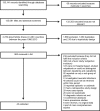Etiology of Severe Febrile Illness in Low- and Middle-Income Countries: A Systematic Review
- PMID: 26126200
- PMCID: PMC4488327
- DOI: 10.1371/journal.pone.0127962
Etiology of Severe Febrile Illness in Low- and Middle-Income Countries: A Systematic Review
Abstract
Background: With apparent declines in malaria worldwide during the last decade and more widespread use of malaria rapid diagnostic tests, healthcare workers in low-resource areas face a growing proportion of febrile patients without malaria. We sought to describe current knowledge and identify information gaps of the etiology severe febrile illness in low-and middle-income countries.
Methods and findings: We conducted a systematic review of studies conducted in low-and-middle income countries 1980-2013 that prospectively assessed consecutive febrile patients admitted to hospital using rigorous laboratory-based case definitions. We found 45 eligible studies describing 54,578 patients; 9,771 (17.9%) had a positive result for ≥1 pathogen meeting diagnostic criteria. There were no eligible studies identified from Southern and Middle Africa, Eastern Asia, Oceania, Latin American and Caribbean regions, and the European region. The median (range) number of diagnostic tests meeting our confirmed laboratory case definitions was 2 (1 to 11) per study. Of diagnostic tests, 5,052 (10.3%) of 49,143 had confirmed bacterial or fungal bloodstream infection; 709 (3.8%) of 18,142 had bacterial zoonosis; 3,488 (28.5%) of 12,245 had malaria; and 1,804 (17.4%) of 10,389 had a viral infection.
Conclusions: We demonstrate a wide range of pathogens associated with severe febrile illness and highlight the substantial information gaps regarding the geographic distribution and role of common pathogens. High quality severe febrile illness etiology research that is comprehensive with respect to pathogens and geographically representative is needed.
Conflict of interest statement
Figures
References
-
- Archibald LK, Den Dulk MO, Pallangyo KJ, Barth Reller L (1998) Fatal Mycobacterium tuberculosis bloodstream infections in febrile hospitalized adults in Dar es Salaam, Tanzania. Clin Infect Dis 26: 290–296. - PubMed
-
- Gordon MA, Walsh AL, Chaponda M, Soko D, Mbvwinji M, et al. (2001) Bacteraemia and mortality among adult medical admissions in Malawi—Predominance of non-typhi Salmonellae and streptococcus pneumoniae. J Infect 42: 44–49. - PubMed
Publication types
MeSH terms
Grants and funding
- R01 TW009237/TW/FIC NIH HHS/United States
- BB/L018845/1/BB_/Biotechnology and Biological Sciences Research Council/United Kingdom
- BB/J010367/1/BB_/Biotechnology and Biological Sciences Research Council/United Kingdom
- BB/L017679/BB_/Biotechnology and Biological Sciences Research Council/United Kingdom
- BB/J010367/BB_/Biotechnology and Biological Sciences Research Council/United Kingdom
LinkOut - more resources
Full Text Sources
Other Literature Sources
Medical



